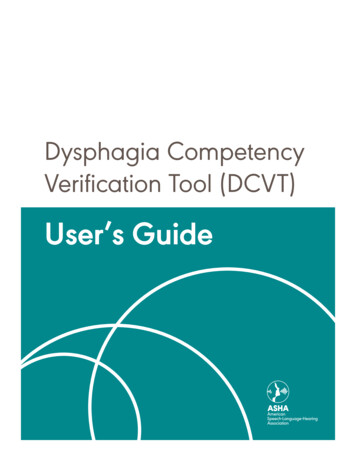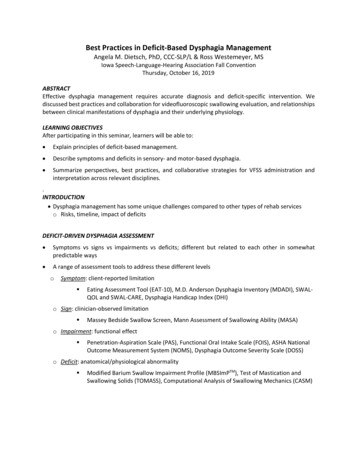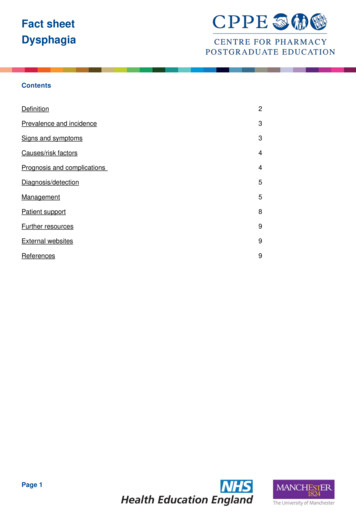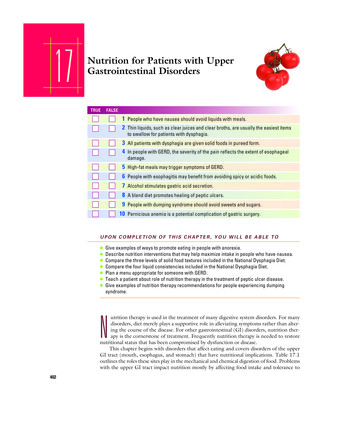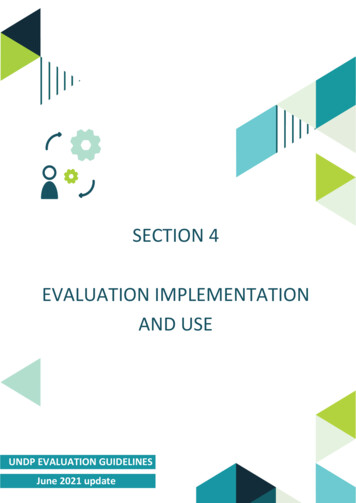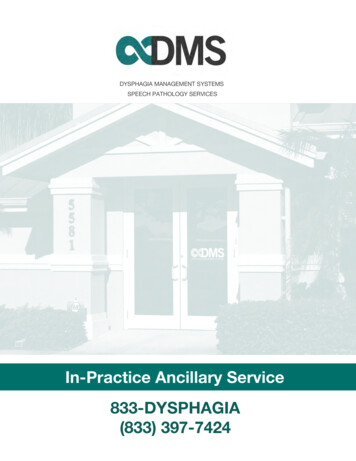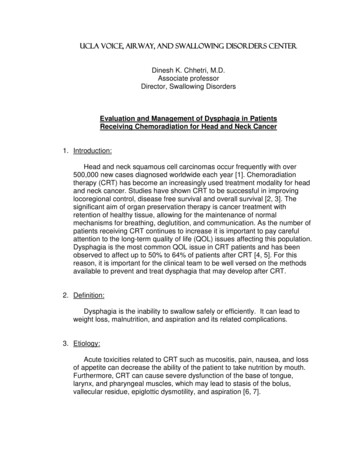
Transcription
UCLA Voice, Airway, and Swallowing Disorders CenterDinesh K. Chhetri, M.D.Associate professorDirector, Swallowing DisordersEvaluation and Management of Dysphagia in PatientsReceiving Chemoradiation for Head and Neck Cancer1. Introduction:Head and neck squamous cell carcinomas occur frequently with over500,000 new cases diagnosed worldwide each year [1]. Chemoradiationtherapy (CRT) has become an increasingly used treatment modality for headand neck cancer. Studies have shown CRT to be successful in improvinglocoregional control, disease free survival and overall survival [2, 3]. Thesignificant aim of organ preservation therapy is cancer treatment withretention of healthy tissue, allowing for the maintenance of normalmechanisms for breathing, deglutition, and communication. As the number ofpatients receiving CRT continues to increase it is important to pay carefulattention to the long-term quality of life (QOL) issues affecting this population.Dysphagia is the most common QOL issue in CRT patients and has beenobserved to affect up to 50% to 64% of patients after CRT [4, 5]. For thisreason, it is important for the clinical team to be well versed on the methodsavailable to prevent and treat dysphagia that may develop after CRT.2. Definition:Dysphagia is the inability to swallow safely or efficiently. It can lead toweight loss, malnutrition, and aspiration and its related complications.3. Etiology:Acute toxicities related to CRT such as mucositis, pain, nausea, and lossof appetite can decrease the ability of the patient to take nutrition by mouth.Furthermore, CRT can cause severe dysfunction of the base of tongue,larynx, and pharyngeal muscles, which may lead to stasis of the bolus,vallecular residue, epiglottic dysmotility, and aspiration [6, 7].
The formation of fibrosis has also been considered a primary source oflate CRT-induced dysphagia. This fibrosis is thought to start with thedysregulation of normal wound healing mechanisms and the addition ofregional oxidative stress secondary to the effects of CRT to surroundingtissue may lead to overproduction of transforming growth factor β1 (TFG-β1),a commonly studied regulator of the fibrotic process [8]. The fibrosis processmay occur independently, extending to adjacent regions. This progressionmay account for the chronic clinical presentation of fibrosis in radiotherapypatients [9].Although neuropathy is clinically considered to be a less common cause ofCRT induced dysphagia, it can occur as the result of neural tumor infiltration,chemotoxicity, or as a late effect of radiotherapy [9]. The NIH Laryngeal StudySection presented preliminary data that has allowed for an improvedunderstanding of the neuromuscular etiology of chronic dysphagia after CRT[10]. In this study, Martin et al. found electromyographic evidence of at leastpartial denervation of the geniohyoid, mylohyoid and thyrohyoid muscles,required to achieve supraglottic closure and upper esophageal opening, in90% of patients that had undergone RT or CRT for head and neck cancer. Ofnote, in the study, intramuscular stimulation at rest induced hyolaryngealmovement similar to that of healthy controls, which implies that the muscles inthese patients were not entirely fibrotic. Although the etiology of neuropathyafter chemoradiotherapy has not been completely described, there ispossibility that brainstem neurotoxicity, peripheral devascularization, andcompressive injury from surrounding fibrosis may be play a role[9,10].The formation of strictures after CRT has also been linked to thedevelopment of dysphagia (Figure 1). Approximately 21% of patients developsymptomatic strictures after undergoing concurrent CRT [11]. CRT results inan increased severity of side effects, as compared with RT alone [11].Furthermore, patients who undergo altered fractionation RT have anincreased risk of developing a stricture [11]. Another significant risk factor forstricture formation is the hypopharyngeal location of the tumor. This siteappears susceptible to stricture formation as it is in close proximity to mucosalmembrane, such as the post-cricoid area and the posterior pharyngeal wall[11]. The mucosal apposition predisposes to fibrosis and stricture formationafter acute mucositis resolves. Female gender has also been implicated as arisk factor for stricture formation [11]. This association may be linked to thefact that females have a decreased pharyngeal circumferential area ascompared with males, which makes the strictures more symptomatic. It hasalso been noted that patients who receive a gastrostomy tube during thecourse of therapy may be at an increased risk of stricture formationsecondary to the relative inactivity of the upper esophageal andhypopharyngeal musculature. For instance patients who had been withoutoral intake for more than 2 weeks during CRT have been found to have worseswallowing scores [12]. Lastly, the duration of treatment-induced mucositis
during CRT has been linked to the development of strictures [13]. Specifically,duration of 15 weeks of treatment-induced mucositis was found to be highlypredictive of stricture formation [13].Figure 1: Esophageal Stenosis after CRT for base of tongue cancer evaluated with officebased trans-nasal esophagoscopy (TNE). The formation of stenosis leads to dysphagia thatis highly amenable to surgical dilation with improvement in swallowing QOL outcomes.4. Epidemiology:Based on published population-based estimate of swallowing outcomesfrom the Surveillance Epidemiology and End Results (SEER) registry andMedicare databases in 8,002 patients with oral, pharyngeal, and laryngealsquamous cell carcinoma, dysphagia was found to occur in approximately64% of patients who had received CRT [4]. Of these, approximately 12%were found to have been diagnosed with strictures. In addition, there wasmore than 2.5-times-greater odds of dysphagia in CRT patients compared tosurgery alone [4].One of the most commonly reported swallowing outcome in the clinicalliterature is the rate of feeding tube dependence. However, it should bementioned that feeding tube dependence may underestimate the burden ofdysphagia, since patients often eat despite clinical evidence of dysphagia oraspiration [9]. The rates of feeding tube dependence have been reported inmost clinical trials as 10% at 1 year and 5% at 2 years [9]. An exceptionwas noticed in the RTOG 99-14 study, which found tube dependence in 41%of patients at 1 year and 22% at 2 years [14].It is generally agreed that aspiration rates are likely underreported instudies that only evaluated symptomatic patients with instrumental
assessment as silent aspiration has been observed in at least a third ofaspirators after treatment with CRT. For instance, in studies that onlyevaluated symptomatic patients, the aspiration rates are between 24% and31% [15,16]. On the other hand, studies that examine both symptomatic andasymptomatic patients with the use of instrumental swallowing evaluationshave reported higher aspiration rates of 30% to 62% [17, 18].5. Quality of Life:Patients suffering from dysphagia have the risk of becoming isolated anddepressed, since they find it difficult to engage in social activities. [19] Forinstance, having dinner in a social setting can cause fear of embarrassmentsecondary to the inability to have normal swallowing function. Nguyen et al.showed that the degree of anxiety, depression, and compromised quality oflife that head and neck cancer patients can experience after treatment can becorrelated with the severity of their dysphagia. [20] In the same study, it wasshown that patients with aspiration, who required prolonged tube feedingshad the worst quality of life [20]. In a different study Nguyen et al. showed thatdysphagia after CRT rarely returned to normal after swallow therapy alone, asassessed by sequential Modified Barium Swallow Studies to monitor longterm dysphagia [21]. Dysphagia specific quality of life assessment tools areavailable [22, 23].6. Diagnosis:The evaluation of dysphagia and aspiration risk after CRT can becomplex. Most patients after CRT suffer from sensory loss of the laryngealand pharyngeal structures. Therefore the cough reflex is often absent orreduced, thus placing the patient at a high risk for silent aspiration.Therefore, instrumental assessments such as videofluoroscopic andendoscopic evaluation of swallowing are important components of swallowingevaluation.A complete history and physical examination of the swallowingmechanism from the lips to the esophagus is essential. Patients will complainof a sensation of food being stuck, reduced ability to swallow, or inability toswallow. Coughing upon swallowing attempts may be present. In severecases of dysphagia patients may be unable to manage their secretions orthere may be a history of aspiration pneumonia. Patients with structurallesions such as pharyngoesophageal stenosis will more likely complain ofsolid food dysphagia unless there in complete stenosis, in which case theywill not pass food of any consistency.The videofluoroscopic swallow study, also known as a modified bariumswallow study (MBSS), allows assessment of the physiology of the patient’s
swallowing mechanism from the lips to the upper esophagus while feedingthe patient with food of different consistencies from liquids to solids [19](Figure 2). Furthermore, if abnormalities in swallowing function are found,various compensatory maneuvers to improve swallowing and decrease therisk of aspiration can be implemented. The clinician should recognize thataspiration has been documented in 68-81% of patients prior of followingchemoradiation of the head and neck, as detected with MBSS [19].Figure 2. Modified Barium Swallow Study (MBSS) – Lateral View. Note barium solution isunable to pass beyond the level of the upper esophagus, signifying presence of anesophageal stricture.Another objective tool to evaluate swallowing dysfunction is functionalendoscopic evaluation of swallowing (FEES). During this procedure, thepharyngeal swallowing phase is visualized from above with a trans-nasalflexible laryngoscope. The advantage of FEES over MBSS is that directobservation of the swallowing anatomy is possible. By using this technique,the anatomy and function of the soft palate, tongue base, pharynx, and larynxcan be assessed during speech and swallowing. Similar to MBSS, food ofvarious consistencies is given to the patient and the swallowing efficiency andabnormalities are directly observed. In addition, the sensitivity of the pharynxcan be evaluated by lightly touching the pharyngeal structures with the tip ofthe endoscope. Furthermore, premature leakage of food or fluid from themouth into the pharynx before a voluntary swallow can be directly visualized,as well as residue in the vallecula, aryepiglottic region, and piriform sinuses[24] (Figure 3). Laryngeal penetration and aspiration, as well as the patients’reaction to residues or aspiration can be noted [24]. It should be mentionedthat FEES can be combined with sensory testing (FEESST), with the use ofair pulse stimuli delivered through a port in the flexible endoscope to themucosa innervated by the superior laryngeal nerve [24]. However, addition of
sensory testing has played very limited roles in the clinical decision makingprocess to recommend a safe diet.Figure 3: Functional Endoscopic Evaluation of Swallowing (FEES). FEES of a post-CRTpatient who developed dysphagia. Notice the significant food residue within the vallecula andthe bilateral pyriform sinuses. Also, note the edematous and thickened epiglottis, whichcontributes to the dysphagia symptoms.FEES and MBSS are complementary tools for evaluation of dysphagia.FEES main advantage is in the direct evaluation of pharyngeal swallowanatomy, whereas MBSS is superior in the dynamic evaluation of the oral andupper esophageal phases of swallowing [24]. Of importance, FEES is apractical and cost-effective test that can be easily performed at bedsidewithout radiation exposure and is a critical assessment tool for theotolaryngologist to evaluate dysphagia [24]. However, FEES only providesindirect information about oral cavity function, and only very limitedimpression of the upper esophageal sphincter function can be made. [25].Another important modality of swallow assessment is esophagoscopy,which can now be performed transnasally in the clinic. This has revolutionizedthe assessment and management of modern swallow assessment andtherapy. In order to directly evaluate the aerodigestive mucosa and detectstructural abnormalities, office esophageal endoscopy can be used. In orderto perform an in office trans-nasal esophagoscopy (TNE), the nasal cavityneeds to be well anesthetized, since the diameter of the scope ranges from4.3 mm to approximately 6.0 mm [26]. After the TNE scope is advancedtrans-nasally into the hypopharynx, the patient is asked to swallow, whichallows the hyolaryngeal complex to elevate and open the upper esophagealsphincter. This provides an appropriate entrance for the TNE scope past thecricopharyngeus muscle into the esophagus. One of the major advantages ofthis procedure is fact that it can be done without general anesthesia or
sedation. Modern endoscope use distal video chip technology that allows theclinician to capture and transmit the image from the distal end of theendoscope. The diagnostic capability of TNE is similar to conventionalesophagoscopy under sedation or general anesthesia. The endoscope hasinternal channels that allow for suction, air and irrigation to be used (Figure4). This is important as air insufflation allows for visualization of theesophagus and stomach, which are normally decompressed [26]. Thechannel also allows procedures such as instillation of medications, biopsy,injection, and other procedures to be performed at the same time.Figure 4: Trans-nasal Esophagoscope (TNE). The distal end of the scope has light, camera,and a working channel. The working channel port (asterisk) allows instrumentation to bepassed to perform procedures.7. Treatment:A. Prevention of DysphagiaThe prevention of dysphagia in chemoradiation patients is extremelyimportant. In order to accomplish this, three approaches can be utilized:Radioprotectors, Radiation Modifications, and Swallow Exercises.Radioprotectors:The radioprotector amifostine (WR2721) is a thiol compound thatprotects normal tissue from the effects of radiation by binding of thesulfhydryl group with hydroxyl radicals [24]. Although there haven’t beengood level I studies to suggest that radioprotectors can alleviatedysphagia, there has been evidence that when head and neck cancerpatients are treated with concomitant CRT with or without amifostine,given before each chemotherapy cycle and less than 45 minutes beforeRT, the side effect profile of treatment is improved. For instance, patients
who received the amifostine regimen experienced less acute levels ofmucositis, xerostomia, loss of taste, and dysphagia [27-29]Radiation ModificationsAs there is a relationship between xerostomia and dysphagia [30],there is a possibility to decrease dysphagia by improving salivary glandfunction. One approach to accomplish this is to use parotid gland-sparingconformal RT or Intensity-Modulated Radiation Therapy (IMRT) [31, 32] InIMRT, the intensity of the radiation beam can be modulated in order todecrease the doses normal tissue is exposed to without compromising thedoses to the tumor. In order to reduce xerostomia and dysphagia, a meanradiation dose to the parotid gland of approximately 26 Gy or less shouldbe the goal [33]In the same way, there have been studies to explain dysphagiaaspiration-related structures (DARS), which when damaged can causedysphagia and aspiration. These structures include: the superior, middleand inferior pharyngeal constrictor muscles, the cricopharyngeal muscle,the esophagus, the glottis and the supraglottis [34, 35, 36]. IMRT canallow for reduced doses to DARS which could potentially lead to improvedswallowing [32, 37, 38]. There have been a number of retrospectivestudies that have shown a correlation between either subjective orobjective assessment of dysphagia and dose volume parameter ofswallowing structures. The data shows that in order to reduce swallowingdysfunction, there needs to be a reduction in the mean doses andvolumes of the DARS that receive 50 Gy or more [39, 35-38].Swallowing ExercisesSwallowing exercise programs are designed to improve swallowphysiology, with the hope of potentially decreasing the severity ofdysphagia before it develops. These exercises can be easily learned bythe patient with the help of the speech language pathologist [40]. Thereare a number of procedures designed to improve the function of particularmuscles or muscle groups. One these exercises are the range of motion(ROM) exercises, which are designed to improve the movement of thetarget swallowing structures. ROM exercises are available for the oraltongue, tongue base, lips, larynx, and hyoid-related musculature [40].
Another type of exercises are the resistance exercises, which aredesigned to strengthen the target structure by stretching it as far aspossible and holding it in extension for several seconds [40]. With this typeof exercise, one can target the tongue, jaw, larynx, and lips. In addition tothese exercises, other frequently performed pre-treatment swallowingexercises include Mendelsohn maneuver, tongue hold, tongue resistance,effortful swallow, and Shaker exercise. It is recommended that theseexercises are performed five times a day and are started 2 weeks beforeRT [40]. The literature has few studies that show an improvement in posttreatment swallowing function and QOL from performing pretreatmentswallowing exercises [41].Swallowing Maneuvers:Swallowing maneuvers are voluntarily controlled during swallow to changea selected aspect of neuromuscular control [40]. These maneuvers include:1. The supraglottic swallow: involves holding vocal fold closure for alonger period of time to protect the airway [42].2. The super-supraglottic swallow: involves closing the airway entrancebefore and during the swallow [43].3. The effortful swallow: increases the pressure generated in thepharynx and the oral cavity during the swallow [42].4. The Mendelsohn maneuver: prolongs and increases the diameter ofthe opening of the upper esophageal sphincter during the swallow bymanually keeping the larynx elevated during swallow [44, 45].It should be mentioned that it is crucial to obtain an excellent swallowingfunction evaluation, in order to identify the abnormal physiological aspect ofthe swallowing mechanism [40]. In the same way, one can instruct the patientto perform a trial of the appropriate maneuver during radiologic evaluation ofswallowing (i.e. MBSS), to determine the effectiveness of the therapy.B. Surgical Treatment:The etiology of dysphagia must be identified via clinical examination anddiagnostic studies to develop a surgical treatment plan. First, it is important torule out the possibility of cancer recurrence as the cause of any progressivedysphagia. In the case of patients with pharyngeal and esophageal stenosis,
as diagnosed with MBSS and endoscopic examination, dilatation of thestenotic region should be performed to decrease obstruction [19]. Sullivan etal. reported that endoscopic dilation can be used successfully in this patientpopulation [46]. Furthermore, our own preliminary data, assessing swallowingfunction after serial stenosis dilation, shows 38% of our chemoradiationpatients resuming a regular diet with no residual dysfunction (Figure 5). Moreimportantly from a QOL perspective, we have found that 89% aregastrostomy-tube (G-tube) independent after serial esophageal dilations inCRT patients who were initially G-tube dependent during or right after CRT.ABFigure 5: Typical outcome after esophageal stenosis dilation procedure. A: Pre-dilationFEES of post-CRT patient who developed esophageal stenosis. Notice pooling of foodresidue in post-cricoid and bilateral pyriform sinuses. Patient is completely G-tube dependentB: Post-dilation FEES. Note the significant improvement in the clearing of food residue fromthe post-cricoid region and the bilateral pyriform sinuses. Patient’s G-tube has beenremoved.It’s important to recognize that patients with dysphagia must be referred toa speech pathologist in the post-operative period for continuing aggressiverehabilitation of swallowing.Currently, the options available for esophageal dilation include themercury-filled rubber Maloney bougies; the wire-guided rigid Savary-Gilliarddilators, the balloon dilators, which can be used either through the endoscopeor wire-guided, and serial esophagoscopes of increasing diameter used asdilators [47] (Figure 6). In general, the selection of the dilator is dependent onthe characteristic of the stricture and the experience of the surgeon. For themost part, the use of the Maloney bougies can be reserved for uncomplicatedand short strictures. On the other hand, the wire-guided Savary-Gilliard dilatorand balloon dilators are both best used for long, tight, or tortuous strictures.The carbon dioxide laser has also been used prior to dilation to optimizeresults. It is very useful to have the TNE or an ultrathin esophagoscopeavailable at the time of stricture dilation. Combined anterograde andretrograde esophagoscopy with dilation is often needed for completestrictures.
Figure 6: Different Types of Dilators Used for Esophageal Stenosis in CRT patients. most suitable, very suitable, suitable, - not suitable, N/A Not applicable. OR Operating Room.Complications related to esophageal dilation are uncommon, but not rare.For instance Sullian et al. observed hypopharyngeal perforation (13%),abdominal wall infection (6%), stomach wall dehiscence (6%), andchondroradionecrosis of the cricoid cartilage (6%) after performing dilations inpost-chemoradiation patients who presented with hypopharyngeal stenosis[46]. Therefore, the clinician should be aware of the fact that patients withradiation-induced or malignant strictures have a significantly high risk ofperforation [47]. In our experience these complications have beenexceedingly rare (manuscript in preparation).8. Prognosis:In general the goal for stenosis dilation should be to obtain a diameter ofgreater than 15 mm. Because of the risk of re-stenosis, it is recommended forthe patient to undergo at least two dilations to optimize results. Also, the useof intralesional injection of steroids and Mitomycin C during the dilationprocedure can decrease the probability of re-stenosis [48, 49]. Continuedvigilance is needed to monitor for re-stenosis and this can be achieved within-office FEES and TNE. Re-stenosis rate is directly related to the degree ofstenosis at the initial dilation. In-office maintenance esophageal dilations canalso be performed safely using balloon dilators and the trans-nasalesophagoscope.
As mentioned earlier, we have found that approximately 38% of ourchemoradiation patients have been able to resume a regular diet with nolimitations after serial dilation of esophageal stenosis and 89% had theirgastrostomy tube removed after treatment and could maintain an oral diet.9. Conclusions:Chemoradiation therapy (CRT) has become an increasingly used mode oftreatment of head and neck cancer. An increasing number of patientsreceiving CRT are surviving; therefore, it is important to pay careful attentionto the long-term side effects affecting this population. Dysphagia has beenobserved to affect up to 50% to 64% of patients after CRT [4, 5]. Dysphagiaafter chemoradiation may be related to a number of issues includingmucositis, severe dysfunction of the base of tongue, larynx, and pharyngealmuscles [6, 7]. The formation of fibrosis has also been considered a primarysource of late chemoradiotherapy-induced dysphagia. Approximately 21% ofpatients develop symptomatic strictures after undergoing concurrentchemoradiation therapy [11]. Patients suffering from dysphagia have the riskof becoming isolated and depressed, since they find it difficult to engage insocial activities [19]. The complete evaluation of patients with dysphagiashould include a thorough history and objective measures such as modifiedbarium swallow study (MBSS), flexible endoscopic evaluation of swallowingFEES, and esophageal endoscopy. It is important to consider preventivemeasures for the development of dysphagia in patients undergoingchemoradiation. The etiology of dysphagia must be identified via clinicalexamination and diagnostic studies to develop an adequate treatment plan.After the possibility of cancer recurrence has been ruled out, treatmentstrategies should include operative interventions of anatomic stenosis as wellas continued aggressive swallow therapy and monitoring of swallowing withinvolvement of a dedicated multidisciplinary team.
Bibliography:[1] Ferlay F, Bray F, Pisani P, Parkin DM. GLOBOCAN 2002: cancerincidence, mortality and prevalence worldwide. IARC Cancer Base No. 5.Version 2.0. Lyon: IARC Press; 2004.[2] Pignon JP, le Maître A, Maillard E, Bourhis J. Meta-analysis ofchemotherapy in head and neck cancer (MACH-NC): an update on 93randomised trials and 17,346 patients. MACH-NC Collaborative Group.Radiother Oncol. 2009 Jul;92(1):4-14. Epub 2009 May 14.[3] Pignon JP, Bourhis J, Domenge C, Designé L. Chemotherapy added tolocoregional treatment for head and neck squamous-cell carcinoma: threemeta-analyses of updated individual data. MACH-NC Collaborative Group.Meta-Analysis of Chemotherapy on Head and Neck Cancer. Lancet. 2000Mar 18;355(9208):949-55.[4] Francis DO, Weymuller EA, Jr., Parvathaneni U, et al. Dysphagia,stricture, and pneumonia in head and neck cancer patients: does treatmentmodality matter? Ann Otol Rhinol Laryngol. 2010;119:391–7.[5] Nguyen NP, Sallah S, Karlsson U, et al. Combined chemotherapy andradiation therapy for head and neck malignancies: quality of life issues.Cancer 2002;94:1131– 41[6] Smith RV, Kotz T, Beitler JJ, Wadler S. Long-term swallowing problemsafter organ preservation therapy with concomitant radiation therapy andintravenous hydroxyurea.Arch OtolaryngolHead Neck Surg2000; 126: 384–389.[7] Lazarus CL, Logemann JA, Pauloski BR et al. Swallowing disorders inhead and neck cancer patients treated with radiotherapy and adjuvantchemotherapy.Laryngoscope1996; 106: 1157–1166.[8] Martin M, Lefaix J, Delanian S. TGF-beta1 and radiation fibrosis: a masterswitch and a specific therapeutic target? Int J Radiat Oncol Biol Phys.2000;47:277–90.[9] Hutcheson KA, Lewin JS Functional Outcomes after Chemoradiotherapyof Laryngeal and Pharyngeal Cancers. Curr Oncol Rep. 2012 Jan 17. [Epubahead of print][10] Martin S, Chung B, Bratlund C, et al. Movement trajectories duringpercutaneous stimulation at rest of the hyolaryngeal muscles in head and
neck cancer patients treated with radiation therapy [abstract]. Dysphagia.2010;25:358.[11] Lee WT, Akst LM, Adelstein DJ, Saxton JP, Wood BG, Strome M, ButlerRS, Esclamado RM. Risk factors for hypopharyngeal/upper esophagealstricture formation after concurrent chemoradiation. Head Neck. 2006Sep;28(9):808-12.[12] Gillespie MB, Brodsky MB, Day TA, Lee Fu-Shing, Martin-Harris B.Swallowing-related quality of life after head and neck cancer treatment.Laryngoscope 2004; 114:1362–1367.[13] Best SR, Ha PK, Blanco RG, Saunders JR Jr, Zinreich ES, Levine MA,Pai SI, Walker M, Trachta J, Ulmer K, Murakami P, Thompson R, Califano JA,Messing BP. Factors associated with pharyngoesophageal stricture inpatients treated with concurrent chemotherapy and radiation therapy fororopharyngeal squamous cell carcinoma. Head Neck. 2011 Dec;33(12):172734. doi: 10.1002/hed.21657. Epub 2011 Jan 18.[14] Garden AS, Harris J, Trotti A, et al. Long-term results of concomitantboost radiation plus concurrent cisplatin for advanced head and neckcarcinomas: a phase II trial of the radiation therapy oncology group (RTOG99–14). Int J Radiat Oncol Biol Phys. 2008;71:1351–5.[15] Goguen LA, Posner MR, Norris CM, et al. Dysphagia after sequentialchemoradiation therapy for advanced head and neck cancer. OtolaryngolHead Neck Surg. 2006;134:916–22.[16] Caudell JJ, Schaner PE, Meredith RF, et al. Factors associated withlong-term dysphagia after definitive radiotherapy for locally advanced headand-neck cancer. Int J Radiat Oncol Biol Phys.2009;73:410–5.[17] Agarwal J, Palwe V, Dutta D, et al. Objective assessment of swallowingfunction after definitive concurrent (chemo)radiotherapy in patients with headand neck cancer. Dysphagia. 2011 [Epub ahead of print].[18] Eisbruch A, Lyden T, Bradford CR, et al. Objective assessment ofswallowing dysfunction and aspiration after radiation concurrent withchemotherapy for head-and-neck cancer. Int J Radiat Oncol Biol Phys.2002;53:23–8.[19] Nguyen NP, Smith HJ, Sallah S. Evaluation and management ofswallowing dysfunction following chemoradiation for head and neck cancer.Curr Opin Otolaryngol Head Neck Surg. 2007 Apr;15(2):130-3.
[20] Nguyen NP, Frank C, Moltz CC, Vos P, Smith HJ, Karlsson U, Dutta S,Midyett A, Barloon J, Sallah S. Impact of dysphagia on quality of life aftertreatment of head-and-neck cancer. Int J Radiat Oncol Biol Phys. 2005 Mar1;61(3):772-8.[21] Nguyen NP, Moltz CC, Frank C, Karlsson U, Smith HJ, Nguyen PD, VosP, Nguyen LM, Rose S, Dutta S, Sallah S. Severity and duration of chronicdysphagia following treatment for head and neck cancer. Anticancer Res.2005 Jul-Aug;25(4):2929-34.[22] Chen AY, Frankowski R, Bishop-Leone J, Hebert T, Leyk S, Lewin J,Goepfert H (2001) The development and validation of a dysphagia-specificquality-of-life questionnaire for patients with head and neck cancer: the M. D.Anderson dysphagia inventory. Arch Otolaryngol Head Neck Surg 127:870–876.[23] McHorney CA, Bricker DE, Robbins J, Kramer AE, Rosenbek JC,Chignell KA (2000) The SWAL-QOL outcomes tool for oropharyngealdysphagia
dysphagia after CRT rarely returned to normal after swallow therapy alone, as assessed by sequential Modified Barium Swallow Studies to monitor long-term dysphagia [21]. Dysphagia specific quality of life assessment tools are available [22, 23]. 6. Diagnosis: The evaluation of dysphagia and aspiration risk after CRT can be complex.
